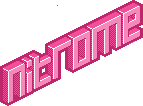
Adobe Flash is a discontinued multimedia software platform used for production of animations, rich internet applications, desktop applications, mobile apps, mobile games, and embedded web browser video players.

A browser game is a video game that is played via the internet using a web browser. They are mostly free-to-play and can be single-player or multiplayer. Alternative names for the browser game genre reference their software platform used, with common examples being Flash games, and HTML5 games.
Miniclip is a Swiss mobile game publisher and former browser game website that was first launched on 30 March 2001. It was started by Robert Small and Tihan Presbie with a budget of £40,000. In 2008, Miniclip was valued at over £275 million. In 2018, the company gained over $400 million in revenue through its mobile gaming hit, 8 Ball Pool.

The Internet country code top-level domain (ccTLD) .io is nominally assigned to the British Indian Ocean Territory. The domain is managed by Internet Computer Bureau Ltd, a domain name registry, with registrar services provided by Name.com.

A mobile game is a video game that is typically played on a mobile phone. The term also refers to all games that are played on any portable device, including from mobile phone, tablet, PDA to handheld game console, portable media player or graphing calculator, with and without network availability. The earliest known game on a mobile phone was a Tetris variant on the Hagenuk MT-2000 device from 1994.
Kongregate is an American web gaming portal and video game publisher. Its website features over 124,000 online games and 30+ mobile games available to the public. The company also publishes games for PC, mobile, and home consoles. It was purchased by GameStop Corporation in 2010 before being acquired by Modern Times Group MT AB in 2017.

Nitrome Games Limited is a British independent video game developer based in London. The company formerly developed Unity-based games for Web browsers, but now publishes and develops games across multiple platforms including mobile, Nintendo Switch, and PS4, with a few releases on Steam.

Supercell Ltd is a Finnish mobile game development company based in Helsinki. Founded on 14 May 2010, the company's debut game was the browser game Gunshine.net, and after its release in 2011, Supercell started developing games for mobile devices. Since then, the company has fully released six mobile games: Hay Day, Clash of Clans, Boom Beach, Clash Royale, Brawl Stars and Squad Busters, which are freemium fast-paced games and have been very successful for the company, the first two generating revenue of €2 million per day in 2013.

PlayCanvas is an open-source 3D game engine/interactive 3D application engine alongside a proprietary cloud-hosted creation platform that allows for simultaneous editing from multiple computers via a browser-based interface. It runs in modern browsers that support WebGL, including Mozilla Firefox and Google Chrome. The engine is capable of rigid-body physics simulation, handling three-dimensional audio and 3D animations.
The Israeli–Palestinian conflict has been the subject of coverage in several video games, mainly smaller ones developed by independent studios or individual lone wolf developers. Games have been made in various genres, frequently tasking the player to take control of the Prime Minister of Israel. Some can be categorized as serious games, others as newsgames or educational games. Many have been controversial.

Fragger is a popular trajectory-based puzzle game created and developed by Harold Brenes and released in 2009 for the Internet. After achieving popularity on the Internet, being played more than 100 million times, it was licensed and ported by Miniclip to iPhone in 2010, and to Android and PlayJam in 2012. By August 2014 it had become the second-placed paid app for iPhone and third overall top-grossing app in Apple's App Store. The gameplay is similar to Angry Birds. The game has had "generally favourable reviews", garnering a Metacritic score of 86% based on 5 critic reviews.

Microsoft Solitaire Collection is a video game developed by Microsoft Casual Games and published by Xbox Game Studios for Microsoft Windows. It combines the Solitaire, FreeCell and Spider Solitaire titles that were included with previous versions of Windows. It also introduces Pyramid and TriPeaks to Windows for the first time, as well as new daily challenges and themes. Unlike the games included in Windows 7 and earlier versions, Microsoft Solitaire Collection is freemium adware with Xbox Live integration.

Slither.io is a multiplayer online video game available for iOS, Android, and web browsers, developed by Steve Howse. Players control an avatar resembling a snake, which consumes multi-colored pellets, both from other players and ones that naturally spawn on the map in the game, to grow in size. The objective of the game is to grow the longest snake in the server. Slither.io is similar in concept to the popular 2015 web game Agar.io and is reminiscent of the classic arcade game Snake.

Surviv.io was a browser-based multiplayer online 2D battle royale game created by Justin Kim and Nick Clark. It was released in October 2017 on its website for desktop browsers, and in October and November 2018 respectively for iOS and Android devices. Similar to other titles in the battle royale genre, players battled against other players on a large map from a top-down perspective, scavenging for supplies and weapons. The game also supported two or four player team modes, and could be played on mobile browsers as well.

ZombsRoyale.io is a battle royale game developed by End Game Interactive. It was released for web browsers in 2018, with iOS and Android ports later that year. A simplified take on the genre, game matches follow up to 100 players who must fight on a large map to be the last survivors. It uses simple 2D graphics and a top-down perspective. The game has amassed over 120,000,000 downloads and unique players across iOS, Android, Web Browser, and PC as of 2024.
Voodoo SAS is a French video game developer and publisher based in Paris. The company was founded in 2013 by Alexandre Yazdi and Laurent Ritter. Voodoo's games, predominantly free-to-play "hyper-casual games", have been collectively downloaded 5 billion times as of May 2021. By February 2022, their apps surpassed 6 billion installs. The company has been criticised for cloning other games.

Diep.io is a multiplayer browser game created by Brazilian developer Matheus Valadares in 2016. It is also the inspiration for Arras.io. Miniclip first published the mobile version. In Diep.io, players control tanks in a two-dimensional arena. They earn experience points and upgrades by destroying shapes and other tanks.
Jaws.io is an action video game based on the 1975 American horror film Jaws. It was developed by Puerto Rican company SRG Studios and published by Universal Studios Interactive Entertainment LLC for iOS and Android devices, and was released on February 14, 2019. The game's servers were shut down on October 31 the same year and is no longer available for download.

GDevelop is a 2D and 3D cross-platform, free and open-source game engine, which mainly focuses on creating PC and mobile games, as well as HTML5 games playable in the browser. Created by Florian Rival, a software engineer at Google, GDevelop is mainly aimed at non-programmers and game developers of all skillsets, employing event based visual programming similar to engines like Construct, Stencyl, and Tynker.

The popularisation of mobile games began as early as 1997 with the introduction of Snake preloaded on Nokia feature phones, demonstrating the practicality of games on these devices. Several mobile device manufacturers included preloaded games in the wake of Snake's success. In 1999, the introduction of the i-mode service in Japan allowed a wide variety of more advanced mobile games to be downloaded onto smartphones, though the service was largely limited to Japan. By the early 2000s, the technical specifications of Western handsets had also matured to the point where downloadable applications could be supported, but mainstream adoption continued to be hampered by market fragmentation between different devices, operating environments, and distributors.















